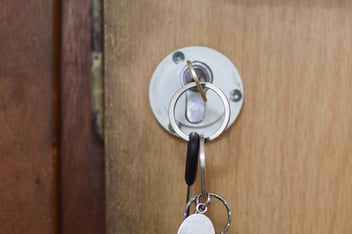Master Key Lock: How Key Cores Fit into a Master Key System

For commercial organizations, the choices made to keep your products, people, and facilities safe can have a big impact on your bottom line. This is why physical security and key control, is so important for organizations of any size.
There are a number of components that contribute to your key control and the ease with which an organization can maintain security while also enabling employees with the access they need to complete their job responsibilities. One of these components is a master key system.
Master keys enable your employees who need more access to a specific location or a number of facilities than a user-level key. With a single master key, a key holder can open any number of doors throughout an organization that are keyed under the master key lock system design. Master keys play an important role in your key control because of the way they both enable and limit access only to those who need it.
What is a Master Key Lock?
A master key lock cylinder can be a standard key core, also known as an interchangeable core, or a conventional lock that is installed in door hardware used in a master key system. A lock that works for a master key is fundamentally no different from a lock that works for user keys. The only difference between a master key lock and a “normal” lock is what key systems that key core is included in.
To understand how key cores contribute to different key systems, it helps to know how a modern lock works. There are pins housed inside a cylinder and a slot for a key to be inserted. An interchangeable core that is not pinned for master key access will open for a single key cut that interacts with the correct pins. An interchangeable core that is part of a master key system will open for a user key and for a master key.
Cost Efficiency With Rekeyable Key Cores
There are a variety of options when choosing what locks to use throughout your organization. One of the decisions you will need to make about your locks that can have a big impact on the day-to-day management of your key control is choosing between a standard interchangeable core and a rekeyable key core.
Rekeyable locks address the cost and time frustrations associated with frequent rekeys. Particularly for commercial organizations with a number of facilities and access points to keep track of, security breaches can quickly become expensive and time-consuming. Rekeyable key cores allow for a lock to be changed without having to remove any of the locking hardware from the door. This cuts down on the cost and storage of backup key cores or locksmith callouts. We have a short video demonstrating how rekeyable key cores work with master keys.
Master Keys and Loss Prevention
One of the biggest reasons that all large organizations should care about their key control is to effectively manage access. An unavoidable part of doing business is trusting your employees to have your company’s best interests in mind. Even great employees occasionally make mistakes, but an accidentally misplaced key can have a significant impact on your organization.
Master keys were designed to solve two problems:
- Master keys provide levels of access so that employees who only need to open a single door or a group of doors keyed alike have access to open only that lock while managers have a higher level of access and can easily open all the doors necessary for their job duties.
- Master keys make it easier for employees who need high-level access to carry only a single key instead of needing a separate key for every door or carrying a janitor key ring with all the keys needed to access everything in their store.
By designating levels of access by need before considering convenience, large organizations can eliminate unnecessary key distribution for employees who need little or no access given to them individually. Good key control relies on managers to designate and track the keys that are distributed at a location. The designation and tracking continue up the chain of command, to include managers for an area or territory up to your loss prevention experts who can use key tracking data to inform strategic security decisions.
One of the easiest ways to cut down on lost or stolen keys is to limit the number of employees who are key holders. While this applies primarily to low-access-level employees who do not need their own individual key, the same principle can apply to master key holders. When designating master key holders and access, provide only as much access as a Location Manager needs to manage their daily responsibilities.
Master Key System Implementation
When implementing a master key system for your company, you’ll need to start with the design. A master key system builds on the foundation of your basic user keys and provides tiered levels of access that form a master key hierarchy. Depending on the size of an organization, there are a number of steps above a user and basic master key. The levels of access look like this:
- User Key: This is the base level of access into your organization. These keys are not master keys and can only open a single lock combination.
- Master Key: This is the base level of master key access. These keys can open any doors with associated master pinned locks, but typically only in a single building.
- Grand Master Key: A grand master key is used in hierarchies that include multiple locations or buildings. These keys can also open any doors fitted with an associated master key lock and offer a higher level of access than a master key. Typically, these keys provide access to multiple buildings in a similar area.
- Great Grand Master Key: This is the highest level of master key access. This key is used in hierarchies that need many tiers of access. Great grand master keys should be very limited in their distribution as they grant the highest level of access to an organization.
Creating the structure of your master key system and associated key cores and users can take time and planning, but the long-term benefits can be significant for your loss prevention, key management, and bottom line. Here at InstaKey, we help large organizations handle the intricacies of effective key control, from hardware to implementation. Click the button below to see examples of our Key Control at work.





